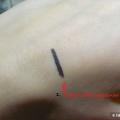Can a tattoo be removed?
Before the invention of safe and effective methods of tattooing, overlap or camouflage remained the main solution to this problem. The method involves filling the previous pattern with a pigment that matches the color of the body. Naturally, this method had enough drawbacks:
painfulness of the procedure, since reducing the tattoo, in fact, was the same as applying a new drawing;
noticeable traces;
the inability to hide large drawings.
Cardinal tattoo removal - surgical excision of the skin along with the pigment. Painful, with a long rehabilitation period and unpleasant consequences in the form of scars. But you can get rid of the picture in just one session.
Cryosurgery of skin exfoliation using liquid nitrogen. Forming an ice crust on the skin, it causes a burn, in the place of which a blister soon appears. Rehabilitation will take at least two weeks: a hard crust appears at the site of the bladder after a few days, after a week it gradually disappears, exposing the young healed skin. Unfortunately, even after the scar has lightened, traces of exposure can be seen on the skin.
How are tattoos removed by electrocoagulation? The method is somewhat similar to the previous one, but the flattening of the skin occurs due to cauterization with electricity. After the procedure, a dry crust forms, which disappears on its own after 1–1.5 weeks. Very often, scars are left as a result of such exposure. The risk of tissue scarring can be minimized by regularly rubbing healing medications into the skin.
And finally, one of the most popular techniques of the past is diamond skin resurfacing (dermabrasion). Using a special cutter, the top layer of the skin is removed along with the pigment. For the best result, at least 2-3 sessions are required with a break of up to two months. The technology has several disadvantages:
permanent injury to the skin reduces the protective properties of the body;
so that pathogens do not get into an open wound, a bandage is constantly worn over the treated area during rehabilitation;
damaged skin must be regularly treated with antiseptic preparations;
a frequent companion of dermabrasion is scars that are difficult to remove.
How to remove a tattoo without scars using a laser?
After getting acquainted with the traditional methods of removing permanent drawings, a natural question arises: is it possible to remove a tattoo painlessly, safely and, most importantly, without scarring?
Laser cosmetology gives an unambiguous and positive answer: with the help of selective photothermolysis, which sends short light pulses, only the pigment is destroyed, and the surrounding skin remains intact. The technology allows you to adjust the depth of laser penetration, so you can reduce the tattoo without scars even if the drawing was applied by the hand of an amateur (and the dyes have gone beyond the epidermis).
If the drawing is small, then the session lasts about 10 minutes using the anesthetic gel. With extensive tattoos, it is possible to use local anesthesia. It is worth remembering that it is completely impossible to remove a drawing at a time - for the best result, you need at least 2-3 procedures.
The Laser Doctor clinic uses a modern Q-Switched Nd: YAG laser device to remove tattoos, which makes it possible to work equally effectively with black, blue or colored pigments. Of the disadvantages of this method, one can only note the price - laser removal is more expensive than many other methods of getting rid of a tattoo.
A few tips on how to remove a tattoo without unpleasant consequences
 There are simple rules to help you avoid side effects when removing tattoos:
There are simple rules to help you avoid side effects when removing tattoos:
Do not trust unverified clinics. Removing a permanent pattern is a complex procedure that requires a highly qualified specialist. The success of the entire procedure depends on how experienced the doctor is.
Don't expect an instant miracle. Tattoos can be removed at a time only with a layer of skin, and even then, if the drawing is done according to all the rules and the pigment has not penetrated into the dermis. As a rule, fresh tattoos are removed more easily and faster than those made several years ago. Expect your beautician to prescribe multiple treatments with a recovery period in between.
Do not ignore the advice of your doctor during the rehabilitation period. If the skin is not treated properly, it can cause inflammation, discoloration, infection, and even scarring of tissues.
In the first days after the procedure, you should limit the contact of the treated area with water and sunlight. It will also be useful for a while to refuse to visit the bathhouse, sauna and solarium.
 How to have the perfect date when you're not romantic
How to have the perfect date when you're not romantic What diseases do you need to drink coffee - benefits and effects
What diseases do you need to drink coffee - benefits and effects All my brown eyeliners
All my brown eyeliners